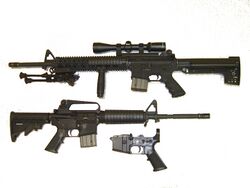Engineering:Receiver (firearms)

In firearms terminology and at law, the firearm frame or receiver is the part of a firearm which integrates other components by providing housing for internal action components such as the hammer, bolt or breechblock, firing pin and extractor, and has threaded interfaces for externally attaching ("receiving") components such as the barrel, stock, trigger mechanism and iron/optical sights.[1]
The receiver is often made of forged, machined, or stamped steel or aluminium. Apart from these traditional materials, modern techniques have introduced polymer and sintered metal powder receivers to the market.[2]
Mounting
A barrel may typically be affixed to a firearm receiver using barrel and receiver action threads or similar methods.
In US law

For the purposes of United States law, the receiver or frame is legally the firearm,[3] and as such it is the controlled part. The definition of which assembly is the legal receiver varies from firearm to firearm, under US law. Generally, the law requires licensed manufacturers and importers to mark the designated receiver with a serial number, the manufacturer or importer, the model and caliber. Makers of receivers are restricted by International Traffic in Arms Regulations. Thus, in the case of a firearm that has multiple receiver parts, such as the AR-15, which has an upper and a lower receiver, the legally controlled part is the one that is serialized.[4]
For the AR-15 rifle, the lower receiver assembly is legally considered the actual receiver,[4] although it is functionally a chassis that also houses the separate trigger group. In the FN-FAL rifle, it is the upper assembly that is serialized and legally considered the receiver.[5][6] This has led to prosecutors dropping charges against illegal manufacturing of AR-type firearms to avoid court precedents establishing that neither the upper nor the lower receiver individually contain all the components to be legally classified as a firearm.[7]
Unfinished receivers
"Unfinished receivers", also called "80 percent receivers" or "blanks", are partially completed receivers with no serial numbers. Purchasers must perform their own finishing work in order to make the receiver usable. The finishing of receivers for sale or distribution by unlicensed persons is against US law.[8] Because an unfinished 80% receiver is not a firearm, purchasers do not need to pass a background check.[8] The resulting firearm is called a privately made firearm, also known as a ghost gun.[9]
During the Biden Administration, the ATF imposed regulations on the sale and marketing of unfinished receivers and kits containing them by revising the legal definition of receivers to include "a partially complete, disassembled, or nonfunctional frame or receiver, including a frame or receiver parts kit, that is designed to or may readily be completed, assembled, restored, or otherwise converted to function as a frame or receiver". (The term "receiver" was also redefined as referring to non-handgun firearms, while "frame" was redefined as referring to handguns exclusively.) The new definitions went into effect on August 24, 2022.[10] In the case VanDerStok v. Garland, filed on June 30, 2023, a federal court in Texas ruled that the new ATF regulations exceeded the agency's statutory authority, and struck them down.[11] However, on August 8, 2023, the Texas court's nationwide vacatur was temporarily placed on hold by the Supreme Court of the United States, leaving the new ATF regulations on unfinished receivers in place.[12]
3D printed receivers
(As of 2015), two designs for 3D printable polymer lower unfinished receivers for the AR-15 have been released: the AR Lower V5 and the Charon. 3D printed designs may also be used to produce privately made firearms.[13]
References
- ↑ "27 CFR 478.11: Meaning of terms". US Government. 2016. http://www.ecfr.gov/. "Firearm frame or receiver. That part of a firearm which provides housing for the hammer, bolt or breechblock, and firing mechanism, and which is usually threaded at its forward portion to receive the barrel."
- ↑ "HK416 modular assault rifle / carbine / upper receiver assembly (Germany)". http://world.guns.ru/assault/as75-e.htm.
- ↑ "Firearms - Frequently Asked Questions - Firearms Technology | ATF". http://www.atf.gov/firearms/faq/firearms-technology.html.
- ↑ 4.0 4.1 Muramatsu, Kevin (2015). "The State of the AR Industry". in Jerry Lee. Gun Digest 2016. Iola, Wisconsin: F+W Media, Inc.. p. 41. ISBN 978-1-4402-4430-8. https://archive.org/details/gundigest20160000unse/page/41/.
- ↑ Jenzen-Jones, N.R.; Spleeters, Damien (31 August 2015). Identifying & Tracing the FN Herstal FAL Rifle: Documenting signs of diversion in Syria and beyond. Australia: Armament Research Services Pty. Ltd.. p. 16. ISBN 978-0-9924624-6-8. https://books.google.com/books?id=MG53CgAAQBAJ&pg=PA16.
- ↑ "27 CFR 478.11: DEFINITION OF FIREARM FRAME OR RECEIVER". ATF. 2008. https://www.atf.gov/file/55436/download.
- ↑ Scott Glover (11 October 2019). "He sold illegal AR-15s. Feds agreed to let him go free to avoid hurting gun control efforts". https://www.cnn.com/2019/10/11/us/ar-15-guns-law-atf-invs/index.html.
- ↑ 8.0 8.1 Horwitz, Sari (May 13, 2014). "'Unfinished receivers,' a gun part that is sold separately, lets some get around the law". Washington Post. https://www.washingtonpost.com/world/national-security/unfinished-receivers-that-can-be-used-to-build-guns-pose-problems-for-law-enforcement/2014/05/13/8ec39e9e-da51-11e3-bda1-9b46b2066796_story.html.
- ↑ Stanton, Sam; Walsh, Denny (December 19, 2015). "California black market surges for 'ghost guns'". Sacramento Bee. http://www.sacbee.com/news/local/crime/article50685560.html.
- ↑ 87 FR 24652
- ↑ VanDerStok v. Garland (US District Court for the Northern District of Texas 2022-08-11) ("This case presents the question of whether the federal government may lawfully regulate partially manufactured firearm components, related firearm products, and other tools and materials in keeping with the Gun Control Act of 1968. Because the Court concludes that the government cannot regulate those items without violating federal law, the Court holds that the government’s recently enacted Final Rule, Definition of “Frame or Receiver” and Identification of Firearms, 87 Fed. Reg. 24,652 (codified at 27 C.F.R. pts. 447, 478, and 479), is unlawful agency action taken in excess of the ATF’s statutory jurisdiction. On this basis, the Court vacates the Final Rule."). Text
- ↑ Liptak, Adam (2023-08-08). "By 5-4 Vote, Supreme Court Revives Biden’s Regulation of 'Ghost Guns'" (in en). The New York Times Company. https://www.nytimes.com/2023/08/08/us/supreme-court-biden-ghost-guns.html.
- ↑ Greenberg, Andy (June 3, 2015). "I Made an Untraceable AR-15 Ghost Gun in My Office And It Was Easy". Wired. Archived from the original on October 20, 2016. https://web.archive.org/web/20161020040839/https://www.wired.com/2015/06/i-made-an-untraceable-ar-15-ghost-gun/. Retrieved October 17, 2016.
 |

